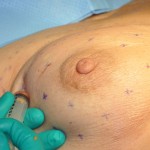Fat grafting by injection continues to grow in popularity and in number of applications. Whether it is for cosmetic or reconstructive purposes, it offers a very focused method for filling soft tissue defects. While fat injections are fairly simple, this does not mean they are without complications. How well the fat survives and does it go on to take and integrate into the surrounding tissues plays a role in an uneventful outcome. Since their use is fairly new, any long-term reports of fat injections in a large number of patients is informative.
In the November 2011 issue of Plastic and Reconstructive Surgery, a study out of Boston reported on the use of fat injections for contour deformities of reconstructed breasts after cancer. They looked at 49 patients (68 breasts) who underwent fat injection grafting. On average, 67ccs of fat was injected into each breast at a single time. They did 111 fat injections which meant that more than one injection was needed in over half the patients. The average follow-up was more than two years. Complications occurred in just over 6% of the patients including such problems as fat necrosis, oil cysts and infection. Of the three, infection was the most infrequent complication, occurring in1% of the patients. The aesthetic results was judged as improved in all cases.

The most useful piece of information in this study is the type and low number of complications. Fat injection necrosis and infection are the expected complications and they were fairly low. Again, this may a reflection of the low volume of fat injected. Larger fat injection volumes, such as may be used in breast or buttock augmentation, may have higher rates of complications.
As this study demonstrates, fat injections are both safe and very useful as a secondary contouring method in breast reconstruction. It demonstrates the growing number of proven areas in which injected fat has a high percentage of survival.
Dr. Barry Eppley
Indianapolis, Indiana


